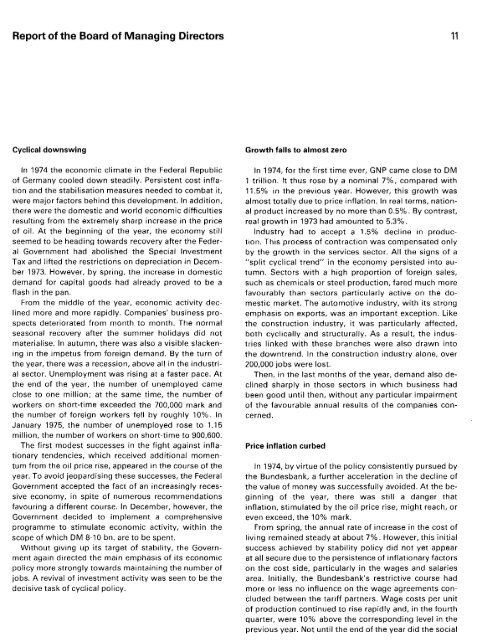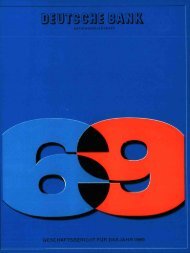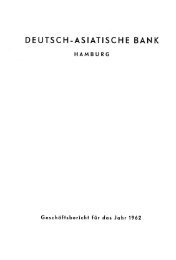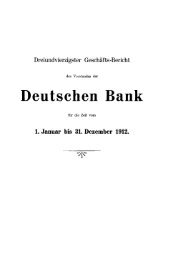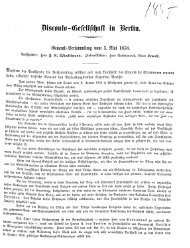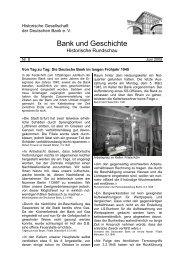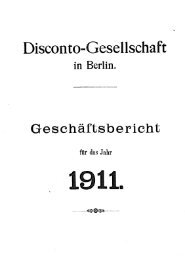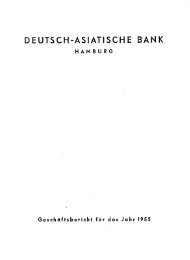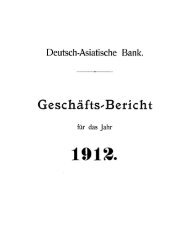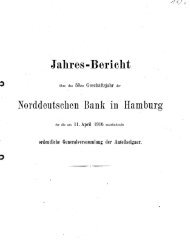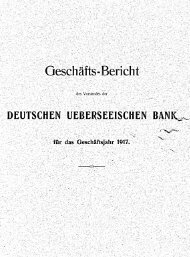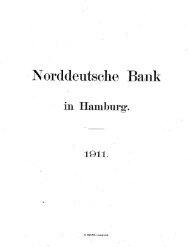Deutsche Bank 1 - Historische Gesellschaft der Deutschen Bank e.V.
Deutsche Bank 1 - Historische Gesellschaft der Deutschen Bank e.V.
Deutsche Bank 1 - Historische Gesellschaft der Deutschen Bank e.V.
Create successful ePaper yourself
Turn your PDF publications into a flip-book with our unique Google optimized e-Paper software.
Report of the Board of Managing Directors<br />
Cyclical downswing Growth falls to almost zero<br />
In 1974 the economic clirnate in the Fe<strong>der</strong>al Republic<br />
of Germany cooled down steadily. Persistent cost infla-<br />
tion and the stabilisation measures needed to combat it,<br />
were rnajor factors behind this development. In addition,<br />
there were the domestic and world econornic difficulties<br />
resulting frorn the extremely sharp increase in the price<br />
of oil. At the beginning of the year, the econorny still<br />
seemed to be heading towards recovery after the Fe<strong>der</strong>-<br />
al Government had abolished the Special Investment<br />
Tax and lifted the restrictions on depreciation in Decem-<br />
ber 1973. However, by spring, the increase in dornestic<br />
demand for capital goods had already proved to be a<br />
flash in the Pan.<br />
Frorn the middle of the year, econornic activity dec-<br />
lined more and rnore rapidly. Companies' business pro-<br />
spects deteriorated frorn rnonth to rnonth. The normal<br />
seasonal recovery after the surnrner holidays did not<br />
materialise. In autumn, there was also a visible slacken-<br />
ing in the irnpetus from foreign <strong>der</strong>nand. By the turn of<br />
the year, there was a recession, above alt in the industri-<br />
al sector. Unemployment was rising at a faster pace. At<br />
the end of the year, the nurnber of unernployed came<br />
close to one million; at the Same time, the number of<br />
workers on short-time exceeded the 700,000 mark and<br />
the nurnber of foreign workers fell by roughly 10%. In<br />
January 1975, the number of unemployed rose to 1.15<br />
rnillion, the nurnber of workers on short-time to 900,600.<br />
The first modest successes in the fight against infla-<br />
tionary tendencies, which received additional rnornen-<br />
tum frorn the oil price rise, appeared in the course of the<br />
year. To avoid jeopardising these successes, the Fe<strong>der</strong>al<br />
Government accepted the fact of an increasingly reces-<br />
sive economy, in spite of nurnerous recornrnendations<br />
favouring a different course. In Decernber, however, the<br />
Government decided to irnplernent a cornprehensive<br />
Programme to stirnulate econornic activity, within the<br />
scope of which DM 8-10 bn. are to be spent.<br />
Without giving up its target of stability, the Govern-<br />
rnent again directed the main ernphasis of its economic<br />
policy rnore strongly towards maintaining the nurnber of<br />
jobs. A revival of investrnent activity was seen to be the<br />
decisive task of cyclical policy.<br />
In 1974, for the first time ever, GNP came close to DM<br />
1 trillion. It thus rose by a nominal 7%. cornpared with<br />
11.5% in the previous year. However, this growth was<br />
almost totally due to price inflation. In real terrns, nation-<br />
al product increased by no more than 0.5%. By contrast,<br />
real growth in 1973 had arnounted to 5.3%.<br />
lndustry had to accept a 1.5% decline in produc-<br />
tion. This process of contraction was compensated only<br />
by the growth in the Services sector. All the signs of a<br />
"split cyclical trend" in the econorny persisted into au-<br />
tumn. Sectors with a high proportion of foreign sales,<br />
such as chernicals or steel production, fared rnuch rnore<br />
favourably than sectors particularly active on the do-<br />
rnestic rnarket. The automotive industry, with its strong<br />
emphasis on exports, was an irnportant exception. Like<br />
the construction industry, it was particularly affected,<br />
both cyclically and structurally. As a result, the indus-<br />
tries linked with these branches were also drawn into<br />
the downtrend. In the construction industry alone, over<br />
200,000 jobs were lost.<br />
Then, in the last months of the year, demand also de-<br />
clined sharply in those sectors in which business had<br />
been good until then, without any particular irnpairrnent<br />
of the favourable annual results of the companies con-<br />
cerned.<br />
Price inflation curbed<br />
In 1974, by virtue of the policy consistently pursued by<br />
the Bundesbank, a further acceleration in the decline of<br />
the value of rnoney was successfully avoided. At the be-<br />
ginning of the year, there was still a danger that<br />
inflation, stirnulated by the oil price rise, might reach, or<br />
even exceed, the 10% mark.<br />
From spring, the annual rate of increase in the cost of<br />
living remained steady at about 7%. However, this initial<br />
success achieved by stability policy did not yet appear<br />
at all secure due to the persistence of inflationary factors<br />
on the cost side, particularly in the wages and salaries<br />
area. Initially, the Bundesbank's restrictive course had<br />
more or less no influence on the wage agreernents con-<br />
cluded between the tariff Partners. Wage costs per unit<br />
of production continued to rise rapidly and, in the fourth<br />
quarter, were 10% above the corresponding level in the<br />
previous year. Not until the end of the year did the social


